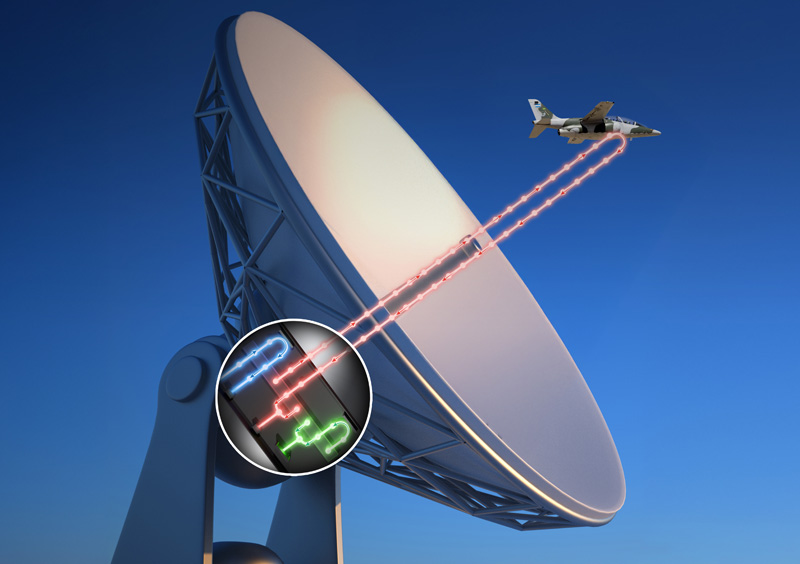Quantum remote sensing approach overcomes quantum memory problem
Path identity the key to scheme that can unlock national security and communications applications
April 3, 2025

Using quantum states of light to detect objects, quantum remote sensing has the potential to enhance applications that depend on fine sensitivity and resolution. But the capability relies on the availability of quantum memory, which has proved challenging to implement. In new work described in Physical Review X, a research team led by Los Alamos National Laboratory has proposed a quantum sensing scheme that overcomes the quantum memory hurdle by coupling entangled frequency comb pairs that use path identity.
“The quantum sensing scheme we have developed achieves a sensing capability that is impossible in classical physics, and which avoids the pitfall of quantum memory,” said Diego Dalvit, Los Alamos physicist and leader of the research effort. “Optical trains of identical laser pulses take advantage of quantum properties to provide information in such a way that is extremely challenging for the target to detect that it is being detected.”
The qCOMBPASS approach — an abbreviation for “quantum frequency combs with path identity for remote sensing of signatures” — uses entangled frequency comb photon pairs that leverage quantum-induced coherence from path identity to retrieve information from a remote target of interest. Already under patent application, qCOMBPASS (a.k.a. quantum radar with undetected photons) has applications in quantum sensing, imaging and ranging for defense, communications and more.
Solving the memory storage problem
In current quantum sensing scenarios, a laser is pumped through a nonlinear crystal, generating a “signal” photon that goes to the target and a twin “idler” photon that is kept in temporary storage; upon the signal photon’s return, final correlation measurements between the two photons indicate the presence of an object. The photons are entangled, or linked despite being far removed from each other in distance, so measuring one unlocks the measurements of the other. The memory storage problem is that photons only maintain their coherence — the lockstep behavior and properties — for a few milliseconds, not always enough time to provide sensing results. This challenge has limited demonstrations to tabletop experiments.
Dalvit and his team proposed to solve the memory storage problem by sending pump laser pulses, whose frequency content resembles a comb pattern, through one nonlinear crystal, resulting in signal and idler frequency comb photon streams. The pump and idler pulses are retroreflected, and the signal pulses travel to the target. Upon retroreflection, pump pulses generate pairs of signal and idler pulses again. Because of the long coherence time of frequency comb lasers (more than 2,000 seconds), the system maintains the coherence of the idler stream and the signal pulses for long enough that the initial signal stream can reach its target and return, and the idler photons can reach a detector.
This innovation enables quantum remote sensing at distances of tens and even hundreds of kilometers.
The key to the delivery of target information to the idler stream, which never reaches the target itself, is path identity. Before detection, the two idler streams are forced to follow the same path, and the two signal streams are also forced to follow another path. The idler detector cannot tell which of the two idler streams is being measured because of photon indistinguishability; this lack of “which-path” information is crucial for generating one-photon quantum interference. Path identity ensures that target information contained in one of the signal streams reflected off target is “teleported” to the idler streams via quantum-induced coherence.
Images with fine sensitivity and high resolution
The qCOMBPASS equation, a quantum analog of the well-known LIDAR equation in classical sensing, predicts the flux of number of idler photons measured in the end. Based on the interference pattern, the team can ascertain a low-noise image of the object being detected, as well as information about the object’s distance, velocity and material composition.
“Potential impacts of this breakthrough are aerospace and defense stealth detection applications, high-resolution imaging for aviation and space exploration, metrology, and communications,” Dalvit said. “We are looking forward to bringing this proposal from the tabletop to a larger-scale demonstration.”
Paper: “Quantum frequency combs with path identity for quantum remote sensing.” Physical Review X. DOI: 10.1103/PhysRevX.14.041058
Funding: This work was funded by the Laboratory Directed Research and Development program at Los Alamos.
LA-UR-24-33020
Contact
Public Affairs | media_relations@lanl.gov